click on the home button to go to the home page
|
The Industrial Era 1952 - 1954 The Second Generation of computers started approximately in this era. They were characterized by electromechanical mechanisms and (partly) programmable in the sense of von Neumann's stored program architecture.
|
pre history | antiquity |
pre industrial era | industrial
era
| 1947 | 1950 | 1952 | 1955 | 1958 | 1961 | 1963 | 1965 | 1969 | 1970 | 1972 | 1974 | 1976 |
| 1978 | 1980 | 1981 | 1982 | 1984 | 1986 | 1989 | 1991 | 1993 | 1994 | 1996 | 2000 | 2002 |
| Related Articles |
| Related Resources |
|
pre history |
![]() IBM
(International Business Machines) decides to add computers to their line of
business equipment products. This will lead IBM to become a dominant force in
this field. The first production-line electronic digital computer from IBM is
Model 701, designed by Nathaniel Rochester
and marketed for scientific use. It includes 1 Kb RAM. The 701 is the first
machine to use a Tape Drive.
IBM
(International Business Machines) decides to add computers to their line of
business equipment products. This will lead IBM to become a dominant force in
this field. The first production-line electronic digital computer from IBM is
Model 701, designed by Nathaniel Rochester
and marketed for scientific use. It includes 1 Kb RAM. The 701 is the first
machine to use a Tape Drive.
![]() A
juicy detail: a complaint against IBM is filed alleging monopolistic practices
in its computer business, in violation of the Sherman act.(2)
(see also 1953 - Philips)
A
juicy detail: a complaint against IBM is filed alleging monopolistic practices
in its computer business, in violation of the Sherman act.(2)
(see also 1953 - Philips)
![]() Grace
Murray Hopper an employee of Remington-Rand works on the UNIVAC.
She takes up the concept of reusable software in her 1952 paper entitled "The
Education of a Computer",(20) and develops the first software
that can translate symbols of higher computer languages into machine language.
(A/O compiler)
Grace
Murray Hopper an employee of Remington-Rand works on the UNIVAC.
She takes up the concept of reusable software in her 1952 paper entitled "The
Education of a Computer",(20) and develops the first software
that can translate symbols of higher computer languages into machine language.
(A/O compiler)

![]() Jay
Forrester develops magnetic core memory at M.I.T.(2) However
An Wang did so in 1948, another fine example of parallel invention.
Jay
Forrester develops magnetic core memory at M.I.T.(2) However
An Wang did so in 1948, another fine example of parallel invention.
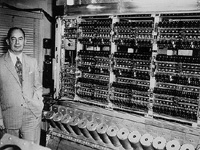
![]() The
EDVAC ( Electronic Discrete Variable
Automatic Computer) is completed at Moore School by Mauchly, Eckert and
Von Neumann
The
EDVAC ( Electronic Discrete Variable
Automatic Computer) is completed at Moore School by Mauchly, Eckert and
Von Neumann
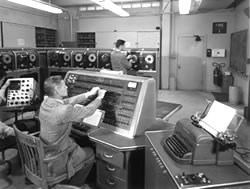
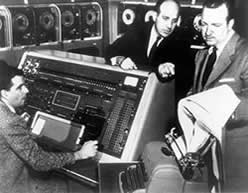
![]() A
UNIVAC I computer made by Remington-Rand
accurately predicts the outcome of the US presidential election, this brings
the computer to the attention of the general public.(2) But
Mr. Cronkite the anchor of the news show and his editor team can not believe
the results that the machine calculated and had the predictions changed. So
it appears, at least to the public, that the computer is wrong, but in fact
it are the editors themselves. They felt it not to be "politically correct"
to make the predictions of the Univac public in such an early stage. Or as others
said later: they could not believe the statistical analysis.
A
UNIVAC I computer made by Remington-Rand
accurately predicts the outcome of the US presidential election, this brings
the computer to the attention of the general public.(2) But
Mr. Cronkite the anchor of the news show and his editor team can not believe
the results that the machine calculated and had the predictions changed. So
it appears, at least to the public, that the computer is wrong, but in fact
it are the editors themselves. They felt it not to be "politically correct"
to make the predictions of the Univac public in such an early stage. Or as others
said later: they could not believe the statistical analysis.
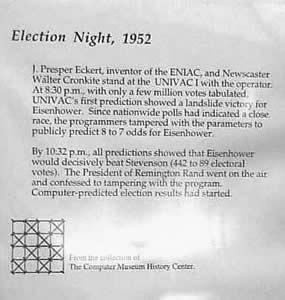
![]() The first computer
manual ever was written by Fred Gruenberger for the University of Wisconsin
Press (15) (16) Prefaced by d'Uzjian (he)
describes (a) future where computer technology will be seamlessly merged into
an appliance that looks and feels remarkably like today's modern microwave oven.
The first computer
manual ever was written by Fred Gruenberger for the University of Wisconsin
Press (15) (16) Prefaced by d'Uzjian (he)
describes (a) future where computer technology will be seamlessly merged into
an appliance that looks and feels remarkably like today's modern microwave oven.
![]() RCA
develops the Bizmac with iron core memory and a magnetic drum supporting the
first Database.
RCA
develops the Bizmac with iron core memory and a magnetic drum supporting the
first Database.
![]() Alick
Glennie develops Auto code, the first compiler. But this one is restricted for
military use only .(11)
Alick
Glennie develops Auto code, the first compiler. But this one is restricted for
military use only .(11)
![]() A first concept
of Integrated Circuits is published by Geoffrey Dummer in Washington.(11)
A first concept
of Integrated Circuits is published by Geoffrey Dummer in Washington.(11)
![]() The very first
computer in the Netherlands is constructed by W.L. van der Poel: Testudo(5).
Construction started in 1947 and completed at TU Delft by students after van
der Poels' design.(3) The relay based machine measures 5 by
0.6 meters. Adding takes 30 seconds and multiplication 45 seconds(6)
The very first
computer in the Netherlands is constructed by W.L. van der Poel: Testudo(5).
Construction started in 1947 and completed at TU Delft by students after van
der Poels' design.(3) The relay based machine measures 5 by
0.6 meters. Adding takes 30 seconds and multiplication 45 seconds(6)
![]() Talking
about bloopers. The Mathematical Center of Amsterdam University puts a computer
made in the Amsterdam, Netherlands on line: Arra.(21) The
system appears however only to be working at the official opening. Gerrit Blaauw
redesigns the Arra and that one will prove to be a success: the Arra II(22)
Talking
about bloopers. The Mathematical Center of Amsterdam University puts a computer
made in the Amsterdam, Netherlands on line: Arra.(21) The
system appears however only to be working at the official opening. Gerrit Blaauw
redesigns the Arra and that one will prove to be a success: the Arra II(22)
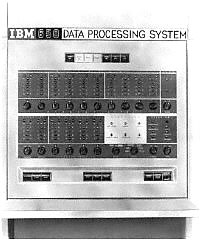 (4) (4) |
IBM introduces the first "mass" produced computer: type 650 also known as the Magnetic Drum Computer. This is a machine between mainframe and micro. Later this breed of machines will be called mini computers. Around 450 will be sold in the first year of production. |
![]() Bell
Telephone Laboratories build the first completely transistorized computer, the
TRADIC. It contains 800 transistors.
Bell
Telephone Laboratories build the first completely transistorized computer, the
TRADIC. It contains 800 transistors.

![]() The
first high speed printer is developed by Remington Rand for use on the UNIVAC
The
first high speed printer is developed by Remington Rand for use on the UNIVAC
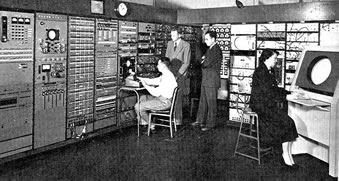 |
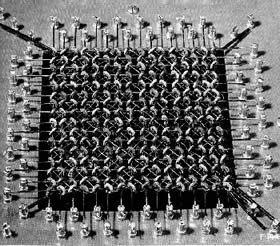 |
![]() Magnetic-core
memory replaced electrostatic tubes on Whirlwind,
doubling the speed, quadrupling the input data rate and reducing memory bank
maintenance time from 4 hours/day to 2 hours/day (11)
Magnetic-core
memory replaced electrostatic tubes on Whirlwind,
doubling the speed, quadrupling the input data rate and reducing memory bank
maintenance time from 4 hours/day to 2 hours/day (11)
![]() ILLIAC
- the world most powerful computer ran at University of Illinois.
ILLIAC
- the world most powerful computer ran at University of Illinois.
![]() In
the Netherlands Philips built the PETER (Philips Experimentele Tweetallig Electronische
Rekenmachine). But by an agreement with IBM Philips promises not to enter the
computer market and developed computers only for internal use(22
In
the Netherlands Philips built the PETER (Philips Experimentele Tweetallig Electronische
Rekenmachine). But by an agreement with IBM Philips promises not to enter the
computer market and developed computers only for internal use(22
![]() First product
to use transistors is on the market: hearing aids
First product
to use transistors is on the market: hearing aids
![]() A
first attempt in automatic translation was done in January when an IBM
701 was used in a research project to translate Russian into English. The
result is enhanced by using electronic dictionaries and a number of programs
that contained the syntax rules of different languages. A satisfactory translation
was achieved. Much of the knowledge gained in this project was used in the Echelon
project
A
first attempt in automatic translation was done in January when an IBM
701 was used in a research project to translate Russian into English. The
result is enhanced by using electronic dictionaries and a number of programs
that contained the syntax rules of different languages. A satisfactory translation
was achieved. Much of the knowledge gained in this project was used in the Echelon
project
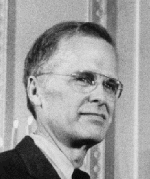 |
John W. Backus an employee of IBM designed the programming language FORTRAN(7) FORTRAN: FORmula TRANslator. Engineers and scientist definitively chose this path of programming with a higher computer language. Rewiring of machines to reprogram them belonged to the past. Another gigantic step forward! (1952: Grace Hopper) Scientist could work independently from programmers and offer their programs directly to computers to run them. It took until 1956 before a manual appeared. Documentation would always be the last thing programmers do obviously. |
![]() In
this year IBM's first commercial computer: IBM 704, was introduced. With build
in indexing and a Floating Point Unit it could reach 40.000 additions per second
and capable of approximately 5 kFLOPS. Principal architect is Gene Amdahl
who also designed the first Operating System
ever for a computer, in this case it was the IBM 704
In
this year IBM's first commercial computer: IBM 704, was introduced. With build
in indexing and a Floating Point Unit it could reach 40.000 additions per second
and capable of approximately 5 kFLOPS. Principal architect is Gene Amdahl
who also designed the first Operating System
ever for a computer, in this case it was the IBM 704
![]() IBM
introduced a the IBM 726. This tape drive wrote 100 characters per inch and
read 75 inches of tape per second. This machine was going to be the standard
drive for several years to come and delivered with all IBM computers.
IBM
introduced a the IBM 726. This tape drive wrote 100 characters per inch and
read 75 inches of tape per second. This machine was going to be the standard
drive for several years to come and delivered with all IBM computers.
![]() Gordon Teal
of Texas Instruments found a way to make transistors from large mono crystals
of cheap silicon oxide. The dimensions were still relatively small: some millimeters
to a few centimeters.
Gordon Teal
of Texas Instruments found a way to make transistors from large mono crystals
of cheap silicon oxide. The dimensions were still relatively small: some millimeters
to a few centimeters.
![]() The first company
to start with mass production of silicon transistors is Texas Instruments
The first company
to start with mass production of silicon transistors is Texas Instruments
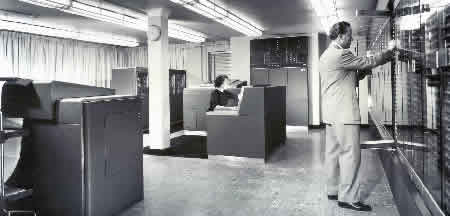
![]() The
NORC (Naval Ordinance Research Computer) is a special made computer constructed
by IBM for the American navy. This machine will be used for logistic services
and contains over 9000 vacuum tubes.
The
NORC (Naval Ordinance Research Computer) is a special made computer constructed
by IBM for the American navy. This machine will be used for logistic services
and contains over 9000 vacuum tubes.
 |
In Japan the Parametron computer is invented. The principle of the Parametron is invented by professor Eiichi Goto. The machine called Musasino I is built in the laboratory of the Japanese PTT (NTT) at Musasino - Japan. The architecture has a strong resemblance to the ILLIAC 1, the one being built on the University of Illinois (USA). The reason was that scientists consciously chose to reuse the program code of the ILLIAC.(10) It will take a few years before this type can be commercialized |
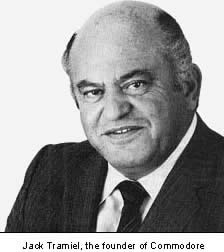
![]()
![]() Jack
Tramiel starts Commodore.
Jack
Tramiel starts Commodore.
This firm will be the one that took the front runner position in the field of
Personal Computers, a term not even coined yet. It would give the greatest push
ever in the hobby computer industry. Commodore marketed famous machines like
the Commodore C64, VIC20 and the Amiga machines. The latter was very advanced
for its time, but hampered by bad quality of parts. However in the first few
years of its existence Commodore would just repair typing machines and related
equipment.
Commodore's most sold computers ever |
||
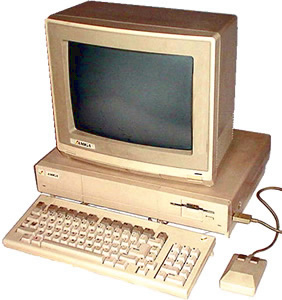 |
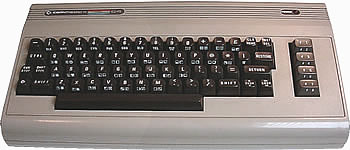 |
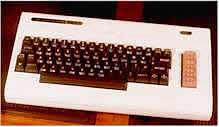 |
|
Commodore Amiga 1000 |
Commodore C64 |
Commodore V20 |
![]() Fujitsu
Ltd. put the first Japanese computer on the marked: the Facom-100. Below is
shown an office situation
Fujitsu
Ltd. put the first Japanese computer on the marked: the Facom-100. Below is
shown an office situation
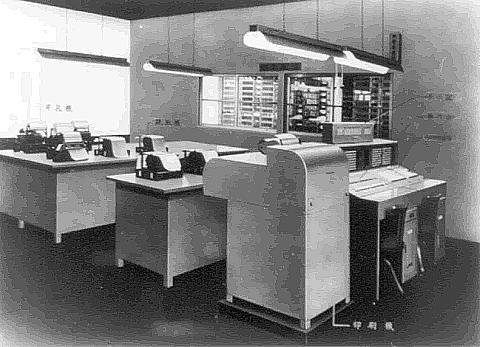
 facom
100
facom
100
![]()
| Last Updated on October 21, 2004 | For suggestions please mail the editors |
Footnotes & References